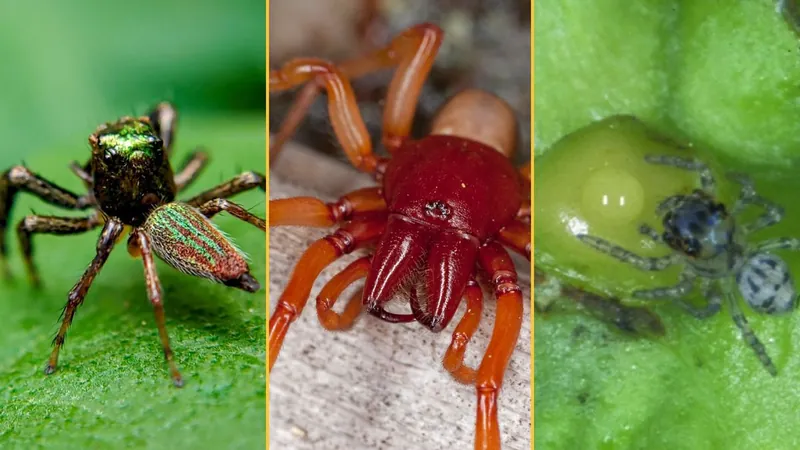
Meet the Fascinating Triad of Spiders: The Vegetarian, The Vampire, and The Woodlice Hunter with Unique Hunting Skills!
2024-09-21
In the vast tapestry of nature, there are approximately 50,000 spider species inhabiting our planet, ranging from giants such as the goliath birdeater to the minuscule dwarf orb weaver. Within this incredible diversity lies a select group of spiders that flaunt highly specialized diets—each with an extraordinary twist. Let’s unravel the unique lives of three unusual spiders that challenge the common perception of predatory behavior.
1. The Vegetarian Spider: Bagheera kiplingi
Scientific Name: Bagheera kiplingi Family: Salticidae Body Length: 5–6 mm (about 0.2-0.24 in) Notable Features: Males flaunt iridescent green markings on their bodies. Diet: An astonishing 60-90% of its diet comes from plant material.
Surprisingly, the jumping spider Bagheera kiplingi is nearly a vegetarian! This diminutive creature primarily feeds on the nutritious Beltian bodies, which are the protein-rich tips of leaves produced by the Vachellia acacia trees. Interestingly, this spider has developed such a dependency on these leaf attachments that it only resides in areas where the Vachellia trees flourish, avoiding territories guarded by their fierce protectors: Pseudomyrmex ants.
This spider’s unique diet not only exemplifies a significant departure from the usual predatory lifestyle of spiders but also showcases an intricate mutual relationship between plants and ants. The acacia trees produce nectar to attract ants that protect them from herbivores, while cunningly, Bagheera kiplingi takes advantage by feeding on their bounty!
2. The Vampire Spider: Evarcha culicivora
Scientific Name: Evarcha culicivora Family: Salticidae Body Length: 3–10 mm (about 0.12-0.4 in) Notable Anatomy: Features a striking red band under its forward-facing eyes. Diet: Specializes in preying on blood-filled female mosquitoes.
Hailing from the Lake Victoria region of Africa, the vampire spider Evarcha culicivora embraces a macabre specialty: it hunts female Anopheles mosquitoes, known vectors for malaria. By feasting on these blood-fed females, this spider doesn’t just quench its thirst for blood; it also enhances its attractiveness during mating rituals, thanks to a “perfume” acquired from its blood-filled meals.
What’s remarkable is that while the spider benefits from a diet that serves its survival and reproductive needs, it inadvertently partakes in malaria control—acting as a natural barrier against the spread of this deadly disease!
3. The Woodlice-Eating Spider: Dysdera crocata
Scientific Name: Dysdera crocata Family: Dysderidae Body Length: Females: 11–15 mm (about 0.43-0.59 in); Males: 9–10 mm (about 0.35-0.39 in) Notable Anatomy: Distinctly broad chelicerae designed for hunting. Specialization: Predominantly feeds on woodlice (terrestrial isopods).
Finally, meet Dysdera crocata, a specialist hunter of woodlice. These spiders are equipped with unique mouthparts that allow them to employ innovative hunting tactics categorized as pincer, fork, and key methods. Each approach is tailored specifically for dealing with the often armored woodlice, and showcases the incredible adaptability of nature.
Woodlice may be slow and shelled, but they can prove daunting foes for most predators. However, these spiders demonstrate patience and precision, making use of their specialized chelicerae to disable their prey before feasting on them. Interestingly, as with other extremes in spider diets, Dysdera exemplifies the dietary adaptations necessary for optimal growth and survival.
It's awe-inspiring to observe how these spiders have evolved to exploit such diverse ecological niches, defying the norms of predation and survival in the spider world. In a time when biodiversity is threatened, these remarkable species remind us of the incredible variety of life on Earth and the delicate interconnections that sustain it.




 Brasil (PT)
Brasil (PT)
 Canada (EN)
Canada (EN)
 Chile (ES)
Chile (ES)
 España (ES)
España (ES)
 France (FR)
France (FR)
 Hong Kong (EN)
Hong Kong (EN)
 Italia (IT)
Italia (IT)
 日本 (JA)
日本 (JA)
 Magyarország (HU)
Magyarország (HU)
 Norge (NO)
Norge (NO)
 Polska (PL)
Polska (PL)
 Schweiz (DE)
Schweiz (DE)
 Singapore (EN)
Singapore (EN)
 Sverige (SV)
Sverige (SV)
 Suomi (FI)
Suomi (FI)
 Türkiye (TR)
Türkiye (TR)